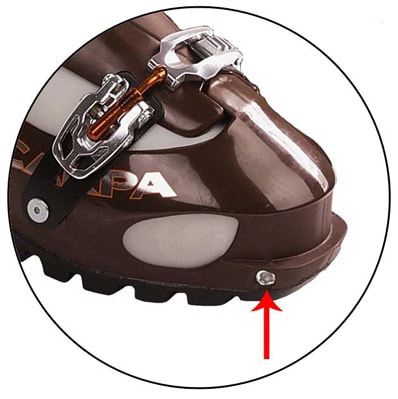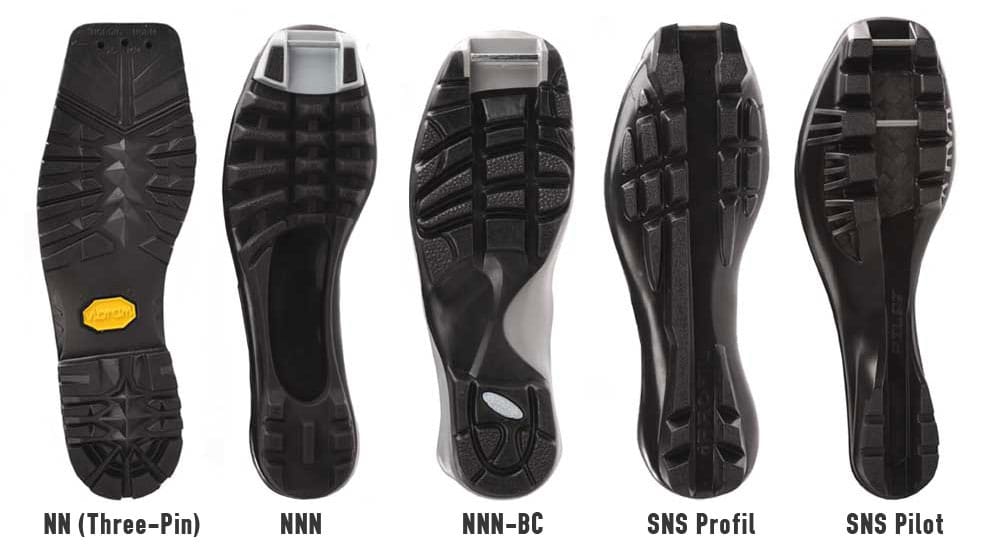
-

Alpine Ski Boots
Alpine ski boots, also known as downhill ski boots, are designed to be used with alpine skis and bindings, which secure both the toe and heel of the boot. Keeping the heel locked down at all times is the main distinction that separates alpine skiing from other types of skiing. For comfort, ski boot liners protect feet from the cold and absorb vibrations. The outer shell of downhill ski boots is constructed of a tough polymer or thermoplastic, such as polyurethane or Pebax®. Alpine ski boots have a pivot point near the ankle that allows the upper shell to flex forward slightly, making it easier to initiate turns. Some boots also have a ski-walk switch. Engaging the walk mode will make it easier to get around on foot.
Telemark Ski Boots
Telemark ski boots look and function a lot like downhill ski boots, except for a unique feature at the forefoot called a bellows. This flex point allows skiers to initiate the classic telemark turn. Boots are either compatible with NN (Nordic Norm) bindings or NTN (New Telemark Norm) bindings. NN boots have a noticeable “duck bill” style toe, and traditionally have three small holes on the underside for compatibility with 75mm telemark bindings. NTN telemark boots look more like alpine boots.
Alpine Touring Ski Boots
Alpine touring is a type of all-mountain skiing that combines aspects of both telemark and alpine skiing. Most AT boots have a walk mode or touring mode that can be toggled on or off using a small lever. Turning the walk mode on makes the boot flex more easily during ascents and touring on flat terrain. Before a descent, switch off the touring mode for added stability. AT boots also have a rubber outsole for traction, should you need to step out of your boots and walk in the snow.
AT bindings also allow a skier to unlock the heel for traversing flat terrain or ascending inclined terrain. For descents, the heel can be locked down. This is a key aspect of AT skiing, and there are a range of different binding systems available. Most AT ski boots are compatible with standard AT bindings. However, only boots with tech fittings are compatible with tech bindings. Dynafit was the first company to manufacture tech bindings. Tech-compatible ski boots have two small metal inserts with circular indentations on each side of the toe cap.

Cross-Country Ski Boots
Since Nordic skiers navigate less aggressive terrain, cross-country ski boots are lighter and less bulky than alpine, telemark and AT boots. Most cross-country ski boots tie using traditional laces and have a waterproof outer cover with a zipper. There are five main types of Nordic bindings, and subsequently five main styles of boot soles: 1) NN (Nordic Norm), NNN (New Nordic Norm), NNN-BC (New Nordic Norm Backcountry), SNS Profil (Salomon Nordic System Profil) and SNS Pilot (Salomon Nordic System Pilot).
It’s important to be aware that these systems are not interchangeable, so be sure the boots you select are compatible with your bindings, or visa versa. Check out the Nordic Skiing Guide for more information on bindings and skis.
Note: NIS (Nordic Integrated System) bindings are compatible with NNN boots.

-

Ski Boot Flex
Ski boot flex is a measurement of the stiffness or forgiveness of a pair of ski boots. A boot with more flex (i.e. less stiffness) will be more comfortable for recreational skiing and more forgiving to beginners. Stiffer boots transfer more energy from skier to ski, which is ideal for aggressive carving. For this reason, advanced skiers usually prefer a stiffer boot. However, there is no industry standard for ski boot flex, so the flex ratings of different brands will vary slightly.
In general, a boot with a stiffness rating of 60-80 will be the most forgiving. Boots in the 80-100 range are usually moderately stiff, and best for intermediate and advanced skiers. Boots in the 100-120 range are stiffer and geared toward advanced skiers. Any boot with 120 or higher stiffness is geared toward aggressive carving and expert ability levels. It’s also important to be aware that women and lightweight individuals will have a harder time flexing a stiffer boot than a heavier person, so weight should also be taken into consideration.
Ski Boot Width
To better accommodate different-sized feet, some brands offer ski boot models in two or three different widths. Similar to athletic footwear, a boot’s last determines the width of the boot. A width measuring 98mm or less is usually best for skiers with narrow feet. A medium width frequently measures around 100mm. For skiers with wider feet, look for a width of 102mm or greater. When measuring the width of your foot, it’s important to measure the widest part of your forefoot. Boots designed for wider feet are sometimes called “high volume” boots. Stiffer boots designed for advanced skiers tend to be narrower or “low volume,” which can make it difficult for advanced skiers with wide feet. However, some brands have begun offering stiffer boots with more volume.
-

Find Your Correct Ski Boot Size
In order to get the best-fitting boot possible, it’s crucial to know your exact foot size. The ideal tool for measuring feet is a Brannock Device, which is used by nearly all shoe stores and ski shops. Most ski boot sizes are represented in Mondopoint sizing, which accounts for both foot length and foot width. If you don’t know your Mondo size, the conversion chart below can help determine what ski boot size is best for you.
Note: Boot size and conversion may vary slightly by brand. To ensure you get the best fit, consider having a boot technician measure your foot in mondopoint.
Mondo US Men US Women Europe UK 15 8 (youth) --- 25 7 15.5 8 (youth) --- 25 7 16 9 (youth) --- 26 8 16.5 9 (youth) --- 26 8 17 10 (youth) --- 27 9 17.5 11 (youth) --- 28 10 18.5 12 (youth) --- 29 11 19.5 13 (youth) --- 30.5 12 20 13.5 (youth) --- 31 13 20.5 1 --- 32 13.5 21 2 --- 33 1 21.5 3 --- 34 2 22 4 5 35 3 22.5 4.5 5.5 36 3.5 23 5 6 36.5 4 23.5 5.5 6.5 37 4.5 24 6 7 38 5 24.5 6.5 7.5 38.5 5.5 25 7 8 39 6 25.5 7.5 8.5 40 6.5 26 8 9 40.5 7 26.5 8.5 9.5 41 7.5 27 9 10 42 8 27.5 9.5 10.5 42.5 8.5 28 10 11 43 9 28.5 10.5 11.5 44 9.5 29 11 12 44.5 10 29.5 11.5 --- 45 10.5 30 12 --- 45.5 11 30.5 12.5 --- 46 11.5 31 13 --- 47 12 31.5 13.5 --- 47.5 12.5 32 14 --- 48 13 32.5 14.5 --- 48.5 13.5 33 15 --- 49 14 33.5 15.5 --- 50 14.5 34 16 --- 51 15 Wear Ski Socks
Before sliding your feet into a pair of ski boots for the first time, slip on some ski socks first. Because modern ski boots have liners specifically designed to fit snuggly and keep feet warm, your ski socks should be relatively lightweight. Socks that are too thick could actually cause tightness or uncomfortable pressure points. Ski socks are also made of moisture-wicking materials like merino wool and synthetic fibers that pull sweat away from your skin to keep feet dry.
Adjust Your Buckles
Most buckles on hard-shell ski boots only have five settings. Can’t seem to find one that feels right? Most modern ski boots have micro-adjust buckles. By simply rotating the clasp of the buckle 360-degrees, you can incrementally increase or decrease the length, helping you achieve that perfect tension.
Consider Upgrading Insoles
Like most footwear, ski boots are designed for people with a low or moderate arch. If you have high arches, stock insoles may not provide the support you need for a full day on the mountain. Adding insoles with more arch support could make a big difference and help reduce foot fatigue.
Be Aware of Ski Boot Break-In Time
All ski boots need to be broken in and will usually feel a little snug out of the box, especially hard-shell boots. This is normal. As you wear them, the new liners will compress slightly, giving your feet and toes a little more wiggle room. If your boots feel roomy out of the box, they could become too loose once they’re broken in. Of course, your new boots shouldn’t be uncomfortably tight, either.
Got Moldable Boot Liners?
Some ski boots feature heat-moldable liners. Although these liners will conform to your feet over time, for the best results, take your new boots into a ski shop and have a qualified technician fit your boots using a specialized heating device. By getting your heat-moldable liners and boots properly fitted, they will require little or no break-in time. Visiting a shop is also a good opportunity to have a technician make other adjustments for an optimal fit.
Properly Adjust Ski Boot Canting
Although they may not be aware of it, some people don’t have a perfectly even stance. For example, one or both knees may bend slightly inward or bow slightly outward. These small imbalances aren’t always noticeable in everyday life, but on the slopes they can prevent your skis from resting perfectly flat on the surface of the snow. This slight misalignment can make skiing more difficult, depending on the degree of imbalance. Not sure if your stance is off? Bring your boots and skis into a shop. A qualified ski tech can check your stance and help compensate for any imbalances by adjusting the canting of your ski boots. If your boots don’t have built-in canting adjustment, ask a technician about your other options.
Special Modifications
If you’ve addressed all of the previous boot fit tips and are still experiencing discomfort or uncomfortable pressure points, you may require additional boot customization. A ski boot technician has several tools that can be used to stretch or reshape certain parts of the boot shell to help relieve pressure points.